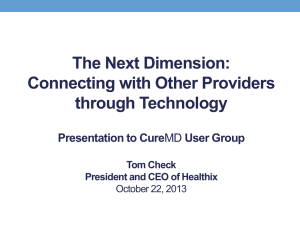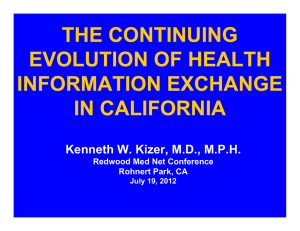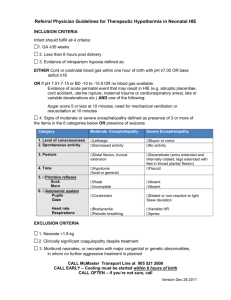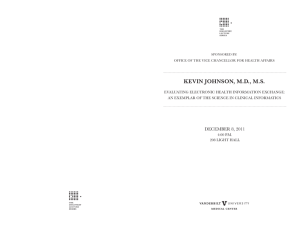Lecture Note 7
advertisement
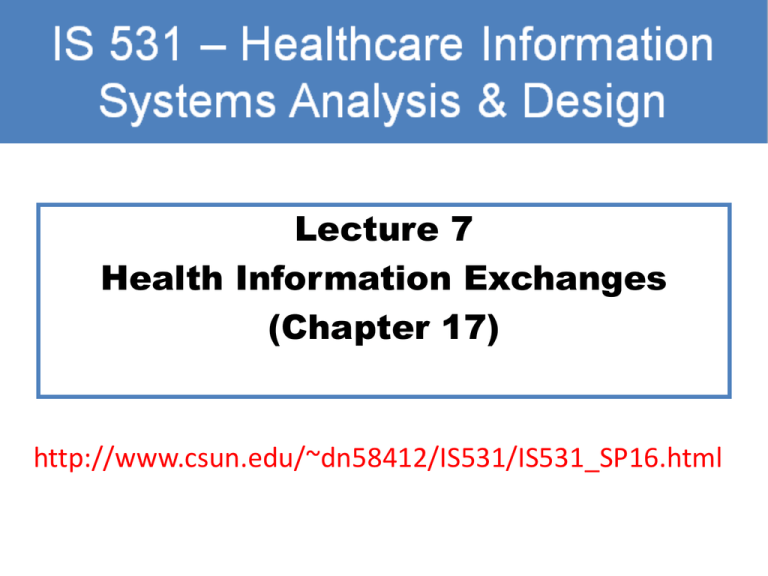
Lecture 7 Health Information Exchanges (Chapter 17) http://www.csun.edu/~dn58412/IS531/IS531_SP16.html Learning Objectives 1. Health Information Exchanges (HIE) and Users 2. Key Factors in HIE 3. HIE Business Models 4. Driving Forces for HIE Development 5. Obstacles to HIE Development IS 531 : Lecture 7 2 Health Information Exchange IS 531 : Lecture 7 3 Health Information Exchange • Electronic movement of health-related information among organizations, • A process within a state health information organization or a regional health information organization • A bidirectional sharing of patient healthrelated information among providers and other authorized healthcare professionals IS 531 : Lecture 7 4 National Health Information Network • NHIN provides a standardized, secure, and confidential way to link information systems together for authorized users to share reliable health-related information IS 531 : Lecture 7 5 Users of Health Information Exchanges • Individual level: enhance personal health outcomes • Professional level: clinical decision making • Agency/organization level : managing operations and quality improvement • Public health and national level: accreditation bodies to evaluate population health, health policy IS 531 : Lecture 7 6 Architecture of Heath Information Exchanges IS 531 : Lecture 7 7 Key Issues in Heath Information Exchanges • • • • • • • • • • • Data storage Master person index (MPI) Record locator service Authentication Authorization Security policies Auditing and logging Standards Scope of services Knowledge of workflow Portals for access IS 531 : Lecture 7 8 Data Storage • To enable the aggregation of data from many sources • Infrastructure models – Centralized – Decentralized / federated – Hybrid IS 531 : Lecture 7 9 Centralized Data Storage IS 531 : Lecture 7 10 Decentralized Data Storage IS 531 : Lecture 7 11 Hybrid Data Storage IS 531 : Lecture 7 12 Master Person Index (MPI) • To uniquely identify an individual • To match the person’s data from many sources • Could be a complex identifier with multiple identification attributes (name, DOB, address) IS 531 : Lecture 7 13 Record Locator Service • A service to search health information that matches the identified individual • Locator can point to a specific types of information / criteria IS 531 : Lecture 7 14 Authentication • To identify authentic users to the systems • Valid users: clinical professionals, public health professionals, supporting IT professionals • Will include patients in future IS 531 : Lecture 7 15 Authorization • Authorized user matrix: WHO can access WHAT information for WHAT purpose • CRUD Function Matrix in database: Create-Read-Update-Delete IS 531 : Lecture 7 16 Security Policies & Procedures • Agreement among organizations to share patient data (retrieve, reuse) • Track requests for information (Require patient consent) • Opt in vs. Opt out IS 531 : Lecture 7 17 Auditing & Logging • Keep track all accesses to network services – Intentional vs. unintentional – Connection vs. disconnection IS 531 : Lecture 7 18 Criteria-based Standards • To assure the interoperability and reuse of information from many sources • Data communication protocols • Data content, format • Technical compatibility among systems IS 531 : Lecture 7 19 Scope of Services Provided IS 531 : Lecture 7 20 Knowledge of Workflow • Data processing procedure (When, Who, How) • Patient data types (What, Whose) IS 531 : Lecture 7 21 Portal for Access • Different portals for different types of information exchanges IS 531 : Lecture 7 22 Health Information Exchange Models • Government-led HIE: direct government program • Public utility HIE: with government oversight • Private sector-led HIE: government as a stakeholder for collaboration and advisement • Public authority HIE : a government created nonprofit authority with powers to operate in a business-like manner IS 531 : Lecture 7 23 Health Information Exchange Business Models • Business models designed for financial sustainability: – Membership fee model – Transaction fee model – Program and service fee model IS 531 : Lecture 7 24 Driving Forces • Reduce data duplication and related costs • Reduce discrepancies among information from may sources and related fixing costs • Provide a uniform holistic picture of the patient’s health to improve care quality • Underlying key success factor: Electronic Health Records (HER) and Electronic Medical Record (EMR) must be first broadly adopted/implemented IS 531 : Lecture 7 25 Current Obstacles Size and scope of the project Time / Costs Critical mass of data to be exchange Collaboration between competitors (providers) • Technical skills / necessary clinical knowledge to use the system • Resistance to change • Composition and structure of governing agency • • • • IS 531 : Lecture 7 26 Future Directions • Statewide HIE initiatives have started – HIE enabler/readiness (coordinating initiaties) – HIE outsourcing/technical partnership (technology implementation and services) – HIE operator (implementation and management) • A national health information network to be build IS 531 : Lecture 7 27 Some References • http://c.ymcdn.com/sites/www.azhec.org/ resource/resmgr/Files/WP_HIE.pdf • http://www.himss.org/resourcelibrary/Topi cList.aspx?MetaDataID=1737 IS 531 : Lecture 7 28

